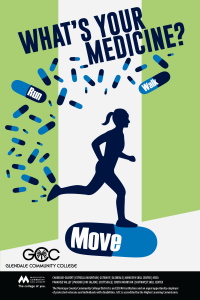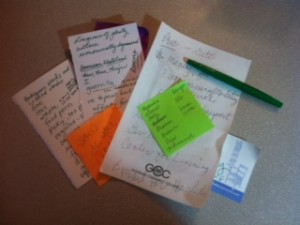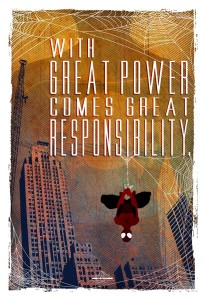By: Phil Arcuria, Research Director
Monthly Archives: March 2015
Making the Most of the Last Five Minutes
We have all been there as a student….the class is close to over; we start gathering materials, opening and closing backpacks, planning our escape as quickly as possible to the door to either run to a next class or sprint to the car to beat traffic. As an instructor though, these final minutes of class are extremely valuable and we need to think of creative, strategic ways to use that time wisely.
As I wrote in my initial “6×6” post, the first five minutes of class are critical to establishing the purpose and tone for the day. Similarly, the final five minutes of class are equally important to assess learning and establish expectations for the next class meeting. Specifically, I believe the final five minutes of class are perfect to administer some type of classroom assessment technique (CAT) to determine, in a low-stakes, low-stress manner, if students learned the content for the day. A resource I have used and shared with others with much success is “Classroom Assessment Techniques: A Handbook for College Instructors” by Thomas Angelo and K. Patricia Cross. This resource includes how-to advice regarding implementing classroom assessment techniques into instruction to determine how well students learned material for the day. The beauty of CATs is 1) instructors receive immediate feedback regarding student learning and 2) instructors can modify instruction based on the results of the assessment to better help students learn. Personally, I have a few favorites. I use “The Minute Paper” at the end of class and ask students to respond to two questions: What was the most important thing you learned during this class? And What important question remains unanswered? I also use concept maps frequently, where students draw or diagram the connections they make between a major concept and other concepts they have learned in the class or throughout the course.
Although I’m more of a dog-lover myself, CATs (in this sense) are something I enjoy and try to keep in my bag of teaching tool tricks as much as possible. And, they really help to make the last five minutes of class more worthwhile and meaningful for students.
For more info about CATs, visit: http://cft.vanderbilt.edu/guides-sub-pages/cats/
It’s All About Your “Hook”
As I was choosing new song lyrics for my students to infer as an activity today, I was thinking about how important it is that I ” hook” my students into a lesson, and this requires constant change, as each semester I see new faces…
Coming from an education background, it is still ingrained in my lesson planning that idea of incorporating an exceptional anticipatory set, or “hook.”
I find this step so imperative in activating my student’s prior knowledge/ schema when introducing a new topic. The change comes when I monitor and adjust the videos, activities, visual aids, and realia I implement each semester as I reflect upon each class. Here are some of my examples:
Video Clips: My RDG 081 students were reading a article on child-rearing styles, and after they read, I chose to have them watch a video clip that added a different type of style than what the article listed. The feedback from the students was very positive, as the video did a nice job of presenting the attributes of each style.
Activities: For my RDG 091 students I use fortune cookies to introduce patterns of organization and transition words. I have them work in small groups of 4-5, and they have to create a paragraph using everyone’s fortune. This type of application makes them think and builds their collaboration skills.
I also use visual images. A perfect example is when I introduce propaganda…I have the students look at different types of advertisements with a partner, and label each advertisement with a sticky note. This is a perfect introduction, as it is relevant, and makes that connection for them as they then have to transfer this skill to reading actual text…
As I plan my lessons….I think ……What can I do to create that spark of interest to engage their minds and curiosity in what they are learning about?
So bottom line is…..Yes, it’s all about your hook!
What I Do When I Have “A Week”: The Human Connection
It’s been a week. Not to over-share, but this week I put $3000 into repairs for my car. This did not even fix the A/C blower that still works inconsistently. Luckily, I can get the blower to work if I open the driver’s door while the car is running and then slam it shut really hard. I thank my eleven year-old for helping me figure out that tip.
Also, this week, my father was diagnosed with Alzheimer’s Disease, and though my family has known for a while that something is terribly wrong with my dad and we weren’t surprised at the diagnosis, I’ve still felt a lot of sadness this week.
In addition, my eleven year-old had a orthodontic installation on Tuesday afternoon, which has now given him a speech impediment. (He thayth hith Th’th funny now.) and a sore mouth. This has made him cranky. He also can’t eat well and has had his fill of pudding, apple sauce, and soup this week.
There are also other stressors on our family plate, like are on all family’s plates, but I’ll spare you those.
So why do I share all of this personal information with people I don’t really know that well? It’s something about that human connection. And that’s the same reason why I teach: for the human connection.
What keeps me afloat in a week like this one? My work. My students. Every day is an opportunity to make a difference in some small way. You have to love a job like that. And I think when I can make a difference, even in a small way, I can step out of my own personal difficulties, even for a little while. While I’m helping a student edit his essay that’s due that evening, I’m wholly invested in our work in that moment together. Then, I don’t have to worry about my dad or my son or the car.
Furthermore, working daily with my students means that I am reminded daily that everyone has challenges. We just all do. I’m no different than any other person who’s sitting in a chair in my class, except that I have my degree, and I get to use it in a meaningful way. Now, I can help others work toward their goals, despite their personal challenges. Keeping in mind that we all have difficulties while attempting to achieve our goals means that I can work with students more mindfully. Like me, like everyone else, they are managing a lot.
Earlier this week, one of my twenty-something year-old students just had surgery to remove thyroid cancer from her body. She emailed me last night to say that the surgery went well but that she is in a lot of pain. I wrote her back and told her to sleep and rest as much as she could. Next week, if she’s able, she can take up her writing again for our course. And then she can use Spring Break to catch up.
Obviously, this student’s cancer surgery this week completely pales my own worries or challenges. In January, she knew this surgery was looming and asked at the beginning of the semester if I would work with her when the time arrived. I said I would. I figure if she wants to continue her education while fighting cancer, she should. In fact, I find her approach to be incredibly brave. It would be easy to give up one’s educational goals in the face of cancer, even if only for the semester.
So I as I teach my students daily, they teach me. And these lessons sustain me–especially through the rough weeks. And I’m sharing all of this with you, just in case maybe just one of you has had a challenging week, too. 🙂
Canvas and Face-to-Face Classes
When I returned to college-level teaching (after almost 20 years break), I felt intimidated by the prospect of using a Learning Management System. Talk about change … we were just barely using email over dial-up on a UNIX prompt (no web browsers yet) last time I was in academia. It wasn’t the technology that intimidated me – it was the fear of using technology as part of my teaching method. I felt outdated, and out-of-touch with new teaching technology.
I couldn’t have been more wrong! Using Canvas as a part of my class has freed me from creating and maintain spreadsheets, updating grade reports, grading tests, and much more. It has also enhanced the learning experience for my students by allowing them to discuss things online, providing a running tally of the assignments due, and providing grades and feedback as soon as something is reviewed or graded by me. It also allows me to communicate with students on a more real-time framework, and it keeps all the paperwork associated with the class in an easy-to-access, organized fashion.
Here are some of the ways I use Canvas for face-to-face classes:
Gradebook – I love this feature. I can set up weights on grades and offer extra credit without having to do much math at all. After I do a set of grading, I usually look at the overall total for each student to see how they are doing in the class as a whole.
Front Page – I have found a way to set up a table for the course home page that I can update each week. I put some kind of picture that represents the area of study and a quote by someone regarding that area of study. I also have spots for Important Links, What is due in the coming week, and a section for honors. I can also put a big, red announcement across the top of the page to emphasize something important (like test dates, etc.).
Assignments and Rubrics – I set up all assignments in Canvas for several reasons. First of all, I must to that to use the gradebook feature. However, by setting up the instructions for the assignment online, I don’t have to worry about students losing the printed assignment instruction sheet. I also set up rubrics, so when I’m grading, I can remain objective and accountable. I also ask students to turn in assignments via Canvas whenever possible – I know exactly when an assignment was turned in (late or on time), and I never have the fear of losing someone’s paper. Also, students can’t claim they turned something in when they really didn’t.
Tests – I hate tests. I like to use projects to assess how students are understanding and applying the material, but I also know that tests are a necessary evil. I also like to use interaction, small group activities, and active learning in class, and I feel that class time is better spent in discussion and activity than in taking tests. I set up quizzes in Canvas, and students must take them within a certain amount of time. The time limit prevents them from looking up every answer, so they must know a bit about what we’ve been discussing in class. However, as we all do in real life – if there is something they are blanking on, they can use notes and text to find the answer. By using this strategy, I have gained three additional class periods that would otherwise be used in testing. … And no more scantrons! Canvas grades them for me, so all I do is look at the statistics in case I have to revisit any of the questions or material later.
Small Group Work – this semester I have assigned small group projects that require a bit of work outside of class. By using the groups feature, students can interact with each other online, which makes it easier given their busy schedules.
Discussions – I use these to make students accountable for preparing for class. I ask them to post one or two things about the reading material, and then comment on someone else’s posts. Then when we use and apply the material in class, they aren’t totally left in the dark, and I don’t have to revert to lecturing.
It’s not a hybrid class, but using the features of Canvas to support my activity in class has opened up all kinds of possibilities to reduce paperwork, but more importantly, enhance student learning. Change, in this case, was good!
Ch-ch-ch-changes
Ch-ch-ch-changes!
The fitness industry is booming these days. What changed, you may ask?
For years, the medical community has been focused on fighting communicable diseases. Vaccines took care of most of these problems. Today we are faced with a more challenging problem…hypokinetic disease…or the disease of inactivity.
The act of sitting too much has made us sick. It is a risk factor for heart disease, stroke, cancer, back pain, obesity, high blood pressure, type 2 diabetes, osteoporosis, osteoarthritis, and many diseases and disorders related to mental health.
Trillions of dollars are spent on this “sickness” industry each year. I cannot fathom “trillions.”
Positive change is afoot.
In 2007, the American Medical Association joined forces with the American College of Sports Medicine to ignite an initiative called Exercise is Medicine. (You have probably heard about it because we are embracing it at GCC!) They are simply asking that exercise be recognized as a medical vital sign. If patients are not getting enough exercise (150 minutes per week), they should be referred to an exercise professional.
A long time ago…before times changed…the exercise professional was the person who liked sports and spent a lot of time in the gym. If you had muscle definition, you were considered an expert.
The fitness professional has evolved, thank goodness. We now have reputable organizations that certify and demand excellence through continuing education. Today’s fitness experts have a solid understanding of the skeletal and neuromuscular systems, they understand the inner workings of the heart and lungs, and they know how to fuel the body with optimum nutrition. They can design individualized exercise programs for a variety of populations, they know how to motivate and lead, and they understand their scope of practice within the allied health continuum.
The other thing that changed that has led to a booming fitness industry is the number of baby boomers hitting retirement. Sedentary baby boomers…
This is great news for graduates of the GCC Exercise Science and Personal Training programs who are looking for immediate entry into the workforce. Back in 1985 GCC was one of the first colleges in the country to offer a personal trainer certification. We were innovators on the cusp of a health revolution.
This health revolution is preventative medicine. It is very simple and it does not require any pills. It simply requires that we move more.
What does this change mean to the faculty, staff, students and GCC community? It’s time to “move” in the right direction and stop sitting so much!
Out With the Old, In With the New Part III
Death by PowerPoint vs. Getting My Act Together With Power Point
Many years ago I attended a workshop presented at Phoenix College by Liz O’Brien, Communications professor. It was called “Death by Power Point;” the purpose of the workshop was to demonstrate how “power points” kill active learning and engagement in the classroom. She modeled how to use power point presentations to guide your lectures and structure the class time. She listed all the “Do Nots,” including too many words, regurgitation of lecture, etc. In the few cases I have used power point, I think I have usually followed her guidelines closely. The most difficult piece for me, of course, is to limit my words. I also find attending power point led presentations boring and monotonous. As a result, I rarely use them in my teaching.
After observing my mentees and their dedicated use of power point, I had an epiphany: Maybe I was being close-minded! :0
I am at the opposite end of “minimalist” on the neatness spectrum. Basically, it’s how I work! After grading a set of papers, you will find mini-lists of points to review when I return them, sticky notes with notes to students, more sticky notes with reminders to myself, and more sticky notes marking places to remember to review or emphasize to students (and that may include a sticky note with an example or two.)
Yes, I overwhelm myself!
SO…I gathered an entire folder of sticky notes and other notes and created a power point presentation! I now have a chapter-by-chapter review of American Wasteland to share with students when I return their RRRLogs (reflections.) Most of the comments, reminders, clarifications, and points to emphasize are the same semester-to-semester so I will not have to rewrite them. I can add/remove as is necessary, it is all in one place, and students can “see” what I am talking about. I do not think I will “put every thing on a power point” but I like the way this little project played out! One more lesson for the mentor from the mentees! Thanks Sherry and Sara!
The Art of Change Can Be at Once Daunting and Exhilarating.
Change n. the act, process or result of making different.Change vb. to make different in some wayMerriam Webster 2010
“Who are you?” said the Caterpillar…“I – I hardly know, Sir, just at present,”Alice replied rather shyly, “at least I know who I was when I got up this morning,but I think I must have changed several times since then.”~ Lewis Carroll, Alice’s Adventures in Wonderland
Like Alice, change and the rapidity of it, can leave us confused, a little baffled, and gulping for air. In fact, if we assimilate transition into our world on a routine basis, the subtlties and impact of change can be welcomed and embraced. William Bridges describes in his book Transitions: Making Sense of Life’s Changes (2004) that every transition begins with an ending, requires time in a neutral zone and is completed when there is a sense of a new beginning. When viewed through this construct, change can be a refreshing way to move on, start anew and be revitalized.
WHAT’S MY PASSWORD?
I don’t know about you but when I transitioned from high school to college I was not ready. Funny thing is when I talked to my dad about it he also indicated that his experience was the same. Both of us bombed out of courses that first semester and had to recover. However he was quicker than me as he went on to get his degree in a few years and I took…20! I was a retention/persistence nightmare student. I never saw an advisor, declared all sorts of majors, went to several colleges, and took a WIDE variety of courses. Now I advise new first year students, Waahahaha!
I am sure it is easy to see why I can identify with the new student. When a student walks onto our campus for the first time it is at that very moment life changes drastically. So much is coming at them that even something as common as setting a password becomes foreign. We expect them to instantly understand, even know, common used words, processes, and requirements. I don’t know about you but I only know what I LEARN and I learn faster if someone takes the time to teach me. FYI, letting a student struggle to figure all this out is NOT student empowerment, that’s just laziness on our part. Going the extra mile will help our students go further down their educational path.
Each time we engage a student we have the opportunity to share in a learning experience. It is in these sorts of engagements that we can create change in our students’ lives, change in our campus, and change in our community. We need to understand that change takes time and it is our job to be patient. Each of us have the POWER to stimulate change in those we encounter by simply taking the time to share our knowledge.
I think Spiderman says it best…
Change That “C” Word!
Change is that “C” word. I love change, and I have learned to embrace it. Many years ago I had a boss that taught me to look at change a bit differently. He explained that change is a challenge, see the “C” word. “No pun intended” 🙂 If you look at the change as a challenge, you are more likely to embrace it. I never looked at change as a challenge until he had said that to me. I began looking at “change” in a different light, and I learned that things and life really did seem a lot better and or easier to handle. Not all changes are bad or even have bad outcomes. So, embrace and appreciate change!
Remember if we are forced to change we usually do not accept it. When we are force to do something your mind is not ready for we rebel. So, don’t be scared of that “C” word.
Once we grasp this kind of concept you will see that change really can be for the good.




